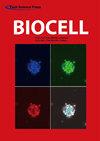香菇多糖功能化硒纳米颗粒通过ros介导的ERK/p53信号通路抑制h2o2诱导的GC2-spg细胞凋亡
IF 1
4区 生物学
Q4 BIOLOGY
引用次数: 0
摘要
建立h2o2诱导的氧化应激损伤细胞模型,探讨纳米硒对小鼠精细胞系的抗氧化作用及氧化应激诱导含硒抗氧化酶表达水平和活性的调控机制。以香菇多糖(LNT)为原料,研制了一种安全有效的功能化含硒纳米粒子(SeNPs)纳米药物体系(SeNPs@LNT)。用SeNPs@LNT(1、2、4、8、16、32 μM)处理小鼠精细胞系GC2-spg细胞24 ~ 72 h,观察硒对细胞的毒性。将GC2-spg细胞随机分为对照组、过氧化氢(H2O2)组、SeNPs@LNT组和H2O2+SeNPs@LNT组。H2O2+SeNPs@LNT组以SeNPs@LNT 4 μM预处理12 h,再以H2O2 600 μM预处理8 h。H2O2组细胞活力降低,SeNPs@LNT组细胞活力显著升高。与H2O2组相比,SeNPs@LNT+H2O2组表现出明显的红色荧光,表明线粒体膜电位水平更高。SeNPs@LNT组细胞内活性氧(ROS)含量显著降低,与H2O2组相比,SeNPs@LNT+H2O2组细胞内绿色荧光强度显著降低,说明SeNPs@LNT对ROS诱导的氧化应激产生有抑制作用。SeNPs@LNT组GPx和SOD活性显著升高。纳米硒干预下p53表达明显降低,GPx1表达升高。氧化应激组DNA损伤相关蛋白和凋亡相关蛋白的表达高于其他各组。由此可见,SeNPs@LNT可通过调节ERK和p53蛋白水平,促进GC2-spg细胞增殖,提高GPx和SOD活性,清除细胞内ROS,减少氧化应激引起的线粒体损伤和功能异常。SeNPs@LNT具有良好的生物活性和抗氧化作用,可用于保护男性生殖系统免受本文章由计算机程序翻译,如有差异,请以英文原文为准。
Inhibition of H2O2-induced apoptosis of GC2-spg cells by functionalized selenium nanoparticles with lentinan through ROS-mediated ERK/p53 signaling pathways
A H2O2-induced oxidative stress injury cell model was established to investigate the antioxidant effect of nanoselenium on mouse spermatocyte lines and the regulation mechanism of the expression level and activity of seleniumcontaining antioxidant enzymes induced by oxidative stress. A safe and effective nano-drug system of functionalized selenium-containing nanoparticles (SeNPs) was developed with lentinan (LNT) (SeNPs@LNT). Mice spermatocyte line GC2-spg cells were treated with SeNPs@LNT (1, 2, 4, 8, 16, 32 μM) for 24–72 h to evaluate the cytotoxicity of selenium. GC2-spg cells were randomly divided into the following groups: control, hydrogen peroxide (H2O2), SeNPs@LNT, and H2O2+SeNPs@LNT groups. H2O2+SeNPs@LNT group was pretreated with SeNPs@LNT 4 μM for 12 h, followed by H2O2 600 μM for 8 h. The cell viability decreased in the H2O2 group and increased significantly in the SeNPs@LNT group. Compared with the H2O2 group, the SeNPs@LNT+H2O2 group exhibited obvious red fluorescence, indicating a higher level of mitochondrial membrane potential. The content of intracellular reactive oxygen species (ROS) in the SeNPs@LNT group reduced significantly, and the intensity of green fluorescence in the SeNPs@LNT+H2O2 group decreased significantly compared with the H2O2 group, indicating the inhibitory effect of SeNPs@LNT on the generation of ROS-induced oxidative stress. The activity of GPx and SOD increased significantly in the SeNPs@LNT group. The expression of p53 decreased significantly under the intervention of nano-selenium, and GPx1 expression increased. In the oxidative stress group, the expressions of DNA damage-related proteins and apoptosis-related proteins were higher than those in other groups. Thus, SeNPs@LNT can promote GC2-spg cell proliferation, improve GPx and SOD activities, remove intracellular ROS, and reduce mitochondrial damage and functional abnormalities caused by oxidative stress by regulating the ERK and p53 protein levels. SeNPs@LNT has good biological activity and antioxidant effect, which can be used to protect the male reproductive system from
求助全文
通过发布文献求助,成功后即可免费获取论文全文。
去求助
来源期刊

Biocell
生物-生物学
CiteScore
1.50
自引率
16.70%
发文量
259
审稿时长
>12 weeks
期刊介绍:
BIOCELL welcomes Research articles and Review papers on structure, function and macromolecular organization of cells and cell components, focusing on cellular dynamics, motility and differentiation, particularly if related to cellular biochemistry, molecular biology, immunology, neurobiology, and on the suborganismal and organismal aspects of Vertebrate Reproduction and Development, Invertebrate Biology and Plant Biology.
 求助内容:
求助内容: 应助结果提醒方式:
应助结果提醒方式:


